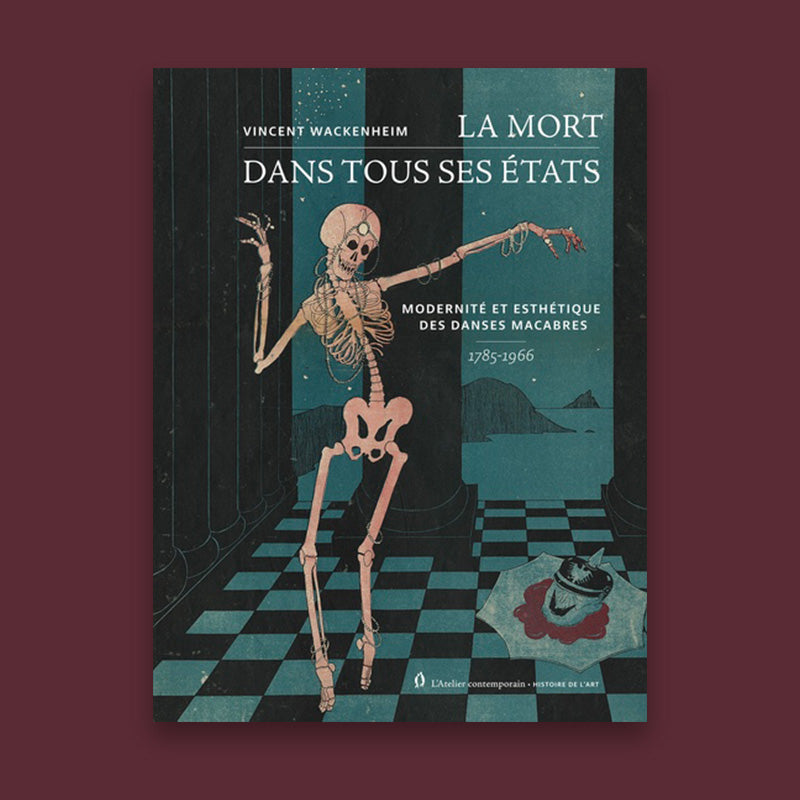Death in all its forms
- Authors: By (author) Vincent Wackenheim
- Publishers: ATELIER CONT
- Date of Publication: 2025-02-14
- Pages: 944
- Dimensions: 287mm x 215mm
Bringing together 104 modern Danses Macabre and more than 1000 commented images,
as well as 11 thematic focuses, Vincent Wackenheim's work bears witness to the
vitality and the durability of an ancient graphic form that many
artists of all nationalities revisited it from the 18th century. The thread
driver is here to show how these, according to the orientations
stylistics of their time, reinterpreted iconic images installed
in the imagination since the 15th century, by integrating, from a
original structure marked by religious history, themes
news, social and political, tragic and burlesque, consequences too
of the two world wars. * From the fresco in the cemetery of
Saints-Innocents in Paris (1424), that of Basel (1440) or engravings of
Holbein (1538), the representations of the Dances of the Dead were codified,
reaching a form of universality in Europe. We see couples composed there
of a dead person, more or less emaciated or skeletal, and of a living person, who
follow in hierarchical order, from the pope to the hermit, from the noble to the lansquenet,
from the peddler to the ploughman. The framework is thus fixed, made of anguish and a
a touch of irony towards the powerful. Because if equality in the face of death is
affirmed, equality on earth is still cruelly lacking. From the end
From the 18th century, the Dances of the Dead will experience an astonishing revival
of interest, made of appropriation, renewal of themes and a great
distancing from the Middle Ages. The extreme readability of the genre,
understandable by all classes of society, the timelessness of the
thematic, its violence and its popularity inscribed in the collective memory,
make artists offer bold interpretations, beyond the
Christian references. Aided by the wide diffusion due to the progress of
printing techniques, the tempo of the Dances of the Dead is now part of
that of modern history, marked by revolutions and unrest
social, the persistence of epidemics and a society in full mutation. The shock
sensitive, visual and tangible aspect of the war is such that the first conflict of
1914-1918 becomes the central subject of a very large number of dances of death,
both in France and in Germany or in England, as well as, to a lesser extent
measure, World War II, not to mention the vision of the universe
concentration camp or the Allied bombings which, in February 1945,
destroyed Dresden. Finally, it is not surprising that, given the situation in the 1950s,
and the Korean War, to see the risks of nuclear conflagration being for
some artists a source of anxiety that we will find translated in their
portfolios. If the Dances of the Dead originally presented a vision sum
all reassuring of society, their modern variations now place
the individual alone facing death: no grieving families, no mourners,
no notaries - only face to face. Death comes to seize the player, the
debauched, the coquette, the miser, because of their faults: this leaves one
to think that these people could have, if not escaped death, at least delayed it
the deadline by leading a regulated life. Each Dance of the Dead thus bears witness to the
through an era: the characters and situations that he captures
Rowlandson, Grandville, Merkel, Barth or Dyl, reveal the perversions, the
ambitions, the conflicts of early 19th century England, of early 19th century France,
1830, from 19th century Germany, from 1920s France, with a focus on
Alongside the extreme violence of the boards, satire, irony and humor.
The eternal fear of dying – and the desire to prepare well for it, giving
pretext for the countless editions of the type De arte bene moriendi, or even for a
craze for Vanities – find an extension in these astonishing
Modern Dances of the Dead, presenting the moment as a piece of eternity
which precedes death, when all is played out, and it then seems vain to
wanting to influence one's destiny.
Share

